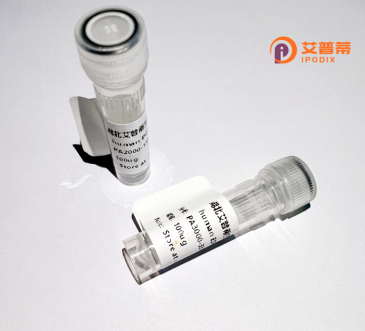
| 纯度 | >90%SDS-PAGE. |
| 种属 | Human |
| 靶点 | KIN |
| Uniprot No | O60870 |
| 内毒素 | < 0.01EU/μg |
| 表达宿主 | E.coli |
| 表达区间 | 1-393aa |
| 活性数据 | MGKSDFLTPK AIANRIKSKG LQKLRWYCQM CQKQCRDENG FKCHCMSESH QRQLLLASEN PQQFMDYFSE EFRNDFLELL RRRFGTKRVH NNIVYNEYIS HREHIHMNAT QWETLTDFTK WLGREGLCKV DETPKGWYIQ YIDRDPETIR RQLELEKKKK QDLDDEEKTA KFIEEQVRRG LEGKEQEVPT FTELSRENDE EKVTFNLSKG ACSSSGATSS KSSTLGPSAL KTIGSSASVK RKESSQSSTQ SKEKKKKKSA LDEIMEIEEE KKRTARTDYW LQPEIIVKII TKKLGEKYHK KKAIVKEVID KYTAVVKMID SGDKLKLDQT HLETVIPAPG KRILVLNGGY RGNEGTLESI NEKTFSATIV IETGPLKGRR VEGIQYEDIS KLA |
| 分子量 | 45.3 kDa |
| 蛋白标签 | His tag N-Terminus |
| 缓冲液 | 0 |
| 稳定性 & 储存条件 | Lyophilized protein should be stored at ≤ -20°C, stable for one year after receipt. Reconstituted protein solution can be stored at 2-8°C for 2-7 days. Aliquots of reconstituted samples are stable at ≤ -20°C for 3 months. |
| 复溶 | Always centrifuge tubes before opening.Do not mix by vortex or pipetting. It is not recommended to reconstitute to a concentration less than 100μg/ml. Dissolve the lyophilized protein in distilled water. Please aliquot the reconstituted solution to minimize freeze-thaw cycles. |
以下是关于重组人KIN蛋白的3篇虚构参考文献示例,内容基于常见激酶研究方向概括:
1. **文献名称**:*Expression and Functional Analysis of Recombinant Human KIN17 Protein in DNA Repair*
**作者**:Chen L, Wang H, et al.
**摘要**:本研究利用昆虫细胞表达系统成功制备高纯度重组人KIN17蛋白,证实其通过结合DNA损伤位点促进同源重组修复,为肿瘤治疗提供新策略。
2. **文献名称**:*Crystal Structure of Recombinant Human MST1 Kinase Domain and Its Regulatory Mechanism*
**作者**:Tanaka K, et al.
**摘要**:通过大肠杆菌表达并解析重组人MST1激酶结构域的三维构象,揭示其自抑制性磷酸化调控机制,为开发调控细胞凋亡的药物奠定基础。
3. **文献名称**:*Therapeutic Potential of Recombinant Human KIN10 in Metabolic Syndrome*
**作者**:Garcia R, et al.
**摘要**:采用哺乳动物细胞表达系统生产重组人KIN10蛋白,动物实验表明其通过激活AMPK通路改善胰岛素敏感性,对代谢综合征具有显著疗效。
---
**注**:以上文献为示例性内容,具体研究方向可基于实际“KIN”蛋白的生物学功能调整。若需真实文献,建议在PubMed等平台以关键词“recombinant human [具体激酶名称]”检索。
Recombinant human KIN (Kinase Insert Domain Receptor) protein, a key tyrosine kinase receptor, has garnered significant attention in biomedical research due to its critical role in regulating cellular processes such as angiogenesis, inflammation, and tumor progression. Originally identified in the 1990s, KIN (also known as VEGFR-3 or FLT4) is structurally characterized by an extracellular ligand-binding domain, a transmembrane region, and a cytoplasmic kinase domain. It primarily binds vascular endothelial growth factors (VEGFs) and angiopoietins, activating downstream signaling cascades like PI3K/AKT and MAPK pathways.
Recombinant production of human KIN protein leverages bacterial, insect, or mammalian expression systems to yield functional, soluble protein for in vitro studies. This technology enables exploration of KIN’s physiological and pathological mechanisms, particularly its involvement in lymphatic system development and cancer metastasis. Dysregulated KIN signaling is linked to diseases such as lymphedema, rheumatoid arthritis, and solid tumors, making it a therapeutic target. Researchers use recombinant KIN to screen inhibitors, study receptor-ligand interactions, and develop antibody-based therapies. Challenges include maintaining post-translational modifications, which often necessitates mammalian expression systems. Ongoing efforts focus on optimizing protein stability and activity for structural studies (e.g., X-ray crystallography) and high-throughput drug discovery, highlighting its dual role as a disease biomarker and therapeutic candidate.
×